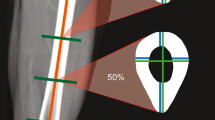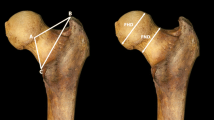Abstract
Sex estimation and the analysis of sexual dimorphism is an essential part of forensic and archaeological studies of skeletons. However, osteologists often have to rely on single measurements, such as femoral head diameters, to estimate sex, especially when skeletons are incomplete. We have obtained a sex-prediction model based on CT images by applying the logistic regression technique to the measurements obtained for the proximal femoral epiphyses and coxal. Nine variables for 114 Spaniards (58 females and 56 males) of known age and sex from a region close to Madrid have been studied. The prediction equation obtained using these nine variables correctly classifies 99.1 % of these individuals. Reducing the equation to the three most explanatory variables (VDH, HDH and MIB) resulted in the correct classification of 98.3 %. These findings suggest that this procedure is highly effective for sex prediction. However, a lack of expertise may produce biases in the measurements obtained from CT images. Moreover, these equations are only most effective for the population for which they were calculated as human growth and body size are sensitive to nutritional variations, environmental stress and the so-called secular trend.



Similar content being viewed by others
References
Walker PL (2008) Sexing skulls using discriminant function of visually assessed traits. Am J Phys Anthropol 136:39–50
Rissech C, Marquez-Grant N, Turbón D (2013) A collation of recently published Western European formulae for age estimation of subadult skeletal remains: recommendations for forensic anthropology and osteoarchaeology. J Forensic Sci 58:S163–S168
Cameriere R, Ferrante L (2008) Age estimation in children by measurement of carpals and epiphyses of radius and ulna and open apices in teeth: a pilot study. Forensic Sci Int 174:59–62
Boccome S, Cremasco MM, Bortoluzzi S et al (2010) Age estimation in subadult Egyptian remains. Homo 61:337–358
Charisi D, Eliopoulos C, Vanna V et al (2011) Sexual dimorphism of the arm bones in a Modern Greek population. J Forensic Sci 56:10–18
Ruff C (2010) Body size and body shape in early hominins. Implications of the Gona pelvis. J Hum Evol 58:166–178
White TD, Black MT, Folken PA (2012) Human osteology, 3rd Ed. Academic
Moore MK (2013) Sex estimation and assessment. In: DiGangi EA, Moore MK (Eds) Research methods in human skeletal biology. Academic, pp 91–116
Spradley MK, Jantz RL (2011) Sex estimation in forensic anthropology: skull versus postcranial elements. J Forensic Sci 56:289–296
Kranioti EF, Vorniotakis N, Galiatsou C, Iscan MY, Michalodimitraki M (2009) Sex identification and software development using digital femoral head radiographs. Forensic Anthropology Population Data. Forensic Sci Int 189:113.e1–113.e7
Robinson C, Eisma R, Morgan B, Jeffery A, Graham EA, Black S, Rutty GN (2008) Anthropological measurement of lower limb and foot bones using multi-detector computed tomography. J Forensic Sci 53(6):1289–1294
Franklin D, Cardini A, Flaver A, Marks MK (2014) Morphometric analysis of pelvic sexual dimorphism in a contemporary Western Australian population. Int J Legal Med. doi:10.1007/s00414-014-0999-8
Giurazza F, Vescovo R, Schena E, Battisti S, Cazatto RL, Grasso FR, Silvestri S, Denaro V, Zobel B (2012) Determination of stature from skeletal and skull measurements by CT scan evaluation. Forensic Sci Int 222:398e1–398.e9. doi:10.1016/j.forsciint.2012.06.008
Giurazza F, Vescovo R, Schena E, Cazatto RL, D’Agostino F, Grasso FR, Silvestri S, Zobel BB (2013) Stature estimation from scapular measurements by CT scan evaluation in an Italian population. Legal Med 15:202–208
Macaluso PJ, Lucena J (2014) Estimation of sex from sternal dimensions derives from chest plate radiographs in contemporary Spaniards. Int J Legal Med 128:389–395
López-Alcaraz M, Garamendi PM, Alemán I, Botella LM (2013) Image analysis of pubic bone for sex determination in a computed tomography sample. Int J Legal Med 127:1145–1155
Asala SA (2001) Sex determination from the head of the femur of South African whites and blacks. Forensic Sci Int 117:15–22
Iscan MY, Miller-Shaivitz P (1986) Sexual dimorphism in the femur and tibia. In: Reichs K (ed) Forensic osteology: advances in identification of human remains. Thomas, Springfield, pp 102–111
Asala SA, Bidmos MA, Dayal MR (2004) Discriminant function sexing of fragmentary femur of South African blacks. Forensic Sci Int 145:25–29
Hauser R, Smoliński J, Gos T (2005) The estimation of stature on the basis of measurements of the femur. Forensic Sci Int 147(2–3):85–190
Patriquin ML, Stein M, Loth SR (2005) Metric analysis of sex differences in South African black and white pelves. Forensic Sci Int 147:119–127
Steyn M, Iscan MY (1997) Sex determination from the femur and tibia in South African whites. Forensic Sci Int 90:111–119
Tague RG (2000) Do big females have big pelves? Am J Phys Anthropol 112:377–393
Tague RG (2005) Big-bodied males help us recognize that females have big pelves. Am J Phys Anthropol 127:392–405
Kurki HK (2011) Pelvic dimorphism in relation to body size and body size dimorphism in humans. J Hum Evol 61:631–643
Manisha R, Dayala MR, Steynb M, Kuykendall KL (2008) Stature estimation from bones of South African whites. S Afr J Sci 104:124–128
Trancho GJ, Robledo B, López-Bueis I, Sánchez JA (1997) Sexual determination of the femur using discriminant functions. Analysis of a Spanish population of known sex and age. J Forensic Sci 42:181–185
Slaus M (1997) Discriminant function sexing of fragmentary and complete femora from medieval sites in continental Croatia. Opuscula Archaeol 21:167–175
Mall G, Graw M, Gehring KD, Hubig M (2000) Determination of sex from femora. Forensic Sci Int 113:315–321
Srivastava R, Saini V, Rai KR, Pandey S, Tripathi SL (2012) A study of sexual dimorphism in the femur along North Indians. J Forensic Sci 57:19–23
Purkait R (2005) Triangle identified at the proximal end of femur: a new sex determinant. Forensic Sci Int 147:135–139
Albanese J, Eklics G, Tuck A (2008) A metric method for sex determination using the proximal femur and fragmentary hipbone. J Forensic Sci 53:1283–1288
Christensen AM, Hatch GM, Brogdon BG (2014) A current perspective on forensic radiology. J Forensic Radiol Imaging. doi:10.1016/j.jofri.2014.05.001
Hatch GM, Dedouit F, Christensen AM, Thali MJ, Ruder TD (2014) RADid: a pictorial review of radiologic identification using postmortem CT. J Forensic Radiol Imaging 2:52–59. doi:10.1016/j.jofri.2014.02.039
Lorkiewicz-Musznska D, Przystanska A, Kociemba W, Sroka A, Rewekant A, Zaba C, Paprzycki W (2013) Body mass estimation in modern population using anthropometric measurements from computed tomography. Forensic Sci Int 231:405.e1–405.e6
Grabherr S, Cooper C, Ulrich-Bochsler S, Uldin T, Ross S, Oesterhelweg L, Bolliger S, Christe A, Schnyder P, Mangin P, Thali MJ (2009) Estimation of sex and age of “virtual skeletons”—a feasibility study. Eur Radiol 19:419–429
Christensen AM, Crowder CM, Ousley SD, Houck MM (2014) Error and its meaning in forensic science. J Forensic Sci 59(1):123–126. doi:10.1111/1556-4029.12275
Hosmer D, Lemeshow S (2004) Applied logistic regression, 2nd edn. Wiley, New York
Albanese J (2003) A metric method for sex determination using the hipbone and the femur. J Forensic Sci 48:263–273
Yamauchi T, Yamazaki M, Okawa A, Furuya T, Hayashi K, Sakuma T, Takahashi H, Yanagawa N, Koda M (2010) Efficacy and reliability of highly functional open source DICOM software (OsiriX) in spine surgery. J Clin Neurosci 17:756–759
Vandenbussche E, Saffarini M, Hansen U, Taillieu F, Mutschler C (2008) The asymmetric profile of the acetabulum. Clin Orthop Relat Res 466:417–423
Kim G, Jung HJ, Lee HJ, Lee JS, Koo S, Chang SH (2012) Accuracy and reliability of length measurements on three-dimensional computed tomography using open-source Osirix software. J Digit Imaging 25:486–491
Lin LI (1989) A concordance coefficient to evaluate reproducibility. Biometrics 45:255–268
Guttman L (1954) A new approach to factor analysis: the Radex. In: Lazarsfeld PF (ed) Mathematical thinking in the social sciences. Free Press, New York, pp 258–348
Kaiser HF (1960) The application of electronic computers to factor analysis. Educ Psychol Meas 20:141–151
Kranioti EF, Bastir M, Sánches-Messeguer A, Rosas A (2009) A geometric morphometric study of the Cretan humerus for the sex identification. Forensic Sci Int 189:113–121
Sakaue K (2004) Sexual determination of long bones in recent Japanese. Anthropol Sci 112:75–81
Slaus M, Strinovic D, Skavic J, Petrovec V (2003) Discriminant function sexing of fragmentary and complete femora: standards for contemporary Croatia. J Forensic Sci 48:509–512
Dittrick J, Suchey JM (1986) Sex determination of prehistoric central California skeletal remains using discriminant analysis of the femur and humerus. Am J Phys Anthropol 70:3–9
Chaudhary AK, Jain SK (2014) Osteoscopic assessment of sexual dimorphism in hip bone. Acta Med Int 1(1):28
Ali RS, MacLaughlin SM (1991) Sex identification from the auricular surface of the adult human ilium. Int J Osteoarchaeol 1(1):57–61
Anderson JY, Trinkaus E (1998) Patterns of sexual, bilateral and interpopulational variation in human femoral neck-shaft angles. J Anat 192:279–285
Pujol A, Rissech C, Ventura J, Badosa J, Turbón D (2014) Ontogeny of the female femur. Geometric morphometric analysis applied on current living individuals of a Spanish population. J Anat. doi:10.1111/joa.12209
Aiello L, Dean C (1990) Human evolutionary anatomy. Academic
Trevathan WR (1987) Human birth. An evolutionary perspective. de Gruyter, New York
Iscan MY, Loth SR, King CA, Shihai D, Yoshino M (1998) Sexual dimorphism in the humerus: a comparative analysis of Chinese, Japanese and Thais. Forensic Sci Int 98:17–29
ISO/TS 21748: 2010. Guidance for the use of repeatability, reproducibility and trueness estimates in measurement uncertainty estimation
Acknowledgments
This work was funded by the projects CGL2006-02170/BTE from the Ministry of Science and Innovation (DT) and 2009SGR-884 from the General Research Directorate of the Generalitat de Catalunya. We would like to thank JM Sevilla, Head of the Radiology Department at the Hospital Universitario de Guadalajara (Castilla-La Mancha health service-SESCAM) for allowing us to obtain the scientific data used in this study. We also thank C. Rissech and G. Trancho for advise on some aspects of this paper.
Author information
Authors and Affiliations
Corresponding author
Rights and permissions
About this article
Cite this article
Clavero, A., Salicrú, M. & Turbón, D. Sex prediction from the femur and hip bone using a sample of CT images from a Spanish population. Int J Legal Med 129, 373–383 (2015). https://doi.org/10.1007/s00414-014-1069-y
Received:
Accepted:
Published:
Issue Date:
DOI: https://doi.org/10.1007/s00414-014-1069-y




